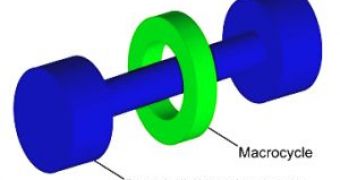The IT industry of the future will be based on what a team of UCLA and the California Institute of Technology are achieving now: a large-scale, "ultra-dense" memory device that uses reconfigurable molecular switches to store information.
This is a crucial phase in the designing of molecular computers that would be much smaller and powerful than today's silicon-based computers.
The 160-kilobit memory device using interlocked molecules is the result of the research of a team at the UCLA laboratory of J. Fraser Stoddart, director of the California NanoSystems Institute (CNSI).
The memory employs a series of perpendicular, crossing nanowires, 400 above and 400 bellow. At each crossing are found about 300 bistable rotaxane molecules, serving as the storage element, and can be switched between two different states, and each junction of a crossbar can be addressed individually by tuning the voltages applied to the top and bottom crossing wires, forming a bit at each nanowire crossing.
This memory was made at a density of 100,000,000,000 (1011) bits per square centimeter, and the technology will be available for commercial use around the year 2020.
Rotaxane (image) is a molecule with dumbbell-shaped component, made up of a slim section ended in two stoppers, and surrounded by a ring. "The molecule can act as a switch provided the ring can be induced to move from one site to the other site and then reside there for many minutes. The bistable rotaxane molecules used in the crossbar memory can be switched at very modest voltages from an "off" (low conductivity) to an "on" (high conductivity) state. The stoppers for the rotaxane molecules are designed to allow the molecules to be organized into single-molecule-thick layers, after which they are incorporated into the memory device," Stoddart said.
"The use of bistable molecules as the unit of information storage promises scalability to this density and beyond. However, there remain many questions as to how these memory devices will work over a prolonged period of time."
"This research is the best example of building large molecular memory in a chip at an extremely high density, testing it and working in an architecture that is practical, where it is obvious how information can be written and read."
"We have shown that if a wire is broken or misaligned, the unaffected bits still function effectively; thus, this architecture is a great example of 'defect tolerance,' which is a fundamental issue in both nanoscience and in solving problems of the semiconductor industry. This research is the culmination of a long-standing dream that these bistable rotaxane molecules could be used for information storage," said Stoddart.
The memory device's top and bottom nanowires, each 16 nanometers wide, were made following a technique developed by a team led by James R. Heath, Caltech's Elizabeth W. Gilloon Professor of Chemistry.
The team led by Stoddart is regarded as the world's leader in making molecular switches, with 25 years of experience. They are pioneers in molecular electronics, employing nanoscale molecules as key functional parts in computers and other electronic devices, like logic gates, memory circuits, sensors. "However, few of these components have been demonstrated to work in practical, highly dense device arrays before," Stoddart said. "One of the most exciting features of this research is that it moves beyond the testing of molecular electronic components in individual, non-scalable device formats and demonstrates a large, integrated array of working molecular devices," said William R. Dichtel, a member of both Stoddart's and Heath's research teams.
"In targeting a large memory array, many fundamental issues of how information is stored and retrieved had to be addressed."
"While this research could affect the computer industry dramatically, it also may have a significant impact on very different uses of information technologies as well," said Heath.
"Molecular switches will lead to other new technologies beyond molecular electronic computers." Stoddart said. "It is too soon to say precisely which ones will be the first to benefit, but they could include areas such as health care, alternative energy and homeland security".
"In 1959, physicist Richard Feynman said it should be possible some day to store all of the Encyclopedia Britannica on the tip of a needle," Stoddart noted. "We're not there yet, but we're not far off."
A joint enterprise between UCLA and the University of California, Santa Barbara, is exploring the potential of engineering "new integrated and emergent systems and devices, by starting down at the nanoscale level, that will aid and abet information technology, energy production, storage and saving, environmental well-being, and the diagnosis, prevention and treatment of chronic and degenerative diseases with an impact that far outstretches our comprehension of life to date," Stoddart said.
Nanosystems operate at a scale ranging from 1 nanometer - about one-billionth of a meter - to a few hundred nanometers. To understand this, you should know that DNA molecule is 2 nm wide, a red blood cell 2,000 nm and a human hair 20,000 nm wide.

 14 DAY TRIAL //
14 DAY TRIAL //